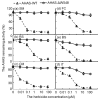Engineering Herbicide-Tolerance Rice Expressing an Acetohydroxyacid Synthase with a Single Amino Acid Deletion
- PMID: 32070060
- PMCID: PMC7072996
- DOI: 10.3390/ijms21041265
Engineering Herbicide-Tolerance Rice Expressing an Acetohydroxyacid Synthase with a Single Amino Acid Deletion
Abstract
The acetohydroxyacid synthase (AHAS) is an essential enzyme involved in branched amino acids. Several herbicides wither weeds via inhibiting AHAS activity, and the AHAS mutants show tolerance to these herbicides. However, most AHAS mutations are residue substitutions but not residue deletion. Here, residue deletion was used to engineering the AHAS gene and herbicide-tolerant rice. Molecular docking analysis predicted that the W548 of the AHAS was a residue deletion to generate herbicide tolerance. The AHAS-ΔW548 protein was generated in vitro to remove the W548 residue. Interestingly, the deletion led to the tetramer dissociation of the AHAS, while this dissociation did not reduce the activity of the AHAS. Moreover, the W548 deletion contributed to multi-family herbicides tolerance. Specially, it conferred more tolerance to sulfometuron-methyl and bispyribac-sodium than the W548L substitution. Further analysis revealed that AHAS-ΔW548 had the best performance on the sulfometuron-methyl tolerance compared to the wild-type control. Over-expression of the AHAS-ΔW548 gene into rice led to the tolerance of multiple herbicides in the transgenic line. The T-DNA insertion and the herbicide treatment did not affect the agronomic traits and yields, while more branched-chain amino acids were detected in transgenic rice seeds. Residue deletion of W548 in the AHAS could be a useful strategy for engineering herbicide tolerant rice. The increase of branched-chain amino acids might improve the umami tastes of the rice.
Keywords: AHAS activity; multi-herbicide tolerance; rice; the W548 deletion.
Conflict of interest statement
The authors declare no conflict of interest.
Figures









Similar articles
-
Characterization of an acetohydroxy acid synthase mutant conferring tolerance to imidazolinone herbicides in rice (Oryza sativa).Planta. 2018 Mar;247(3):693-703. doi: 10.1007/s00425-017-2817-2. Epub 2017 Nov 23. Planta. 2018. PMID: 29170911
-
Amino acids conferring herbicide resistance in tobacco acetohydroxyacid synthase.GM Crops. 2010 Mar-Apr;1(2):62-7. doi: 10.4161/gmcr.1.2.10856. GM Crops. 2010. PMID: 21865873 Review.
-
Ser-653-Asn substitution in the acetohydroxyacid synthase gene confers resistance in weedy rice to imidazolinone herbicides in Malaysia.PLoS One. 2020 Sep 14;15(9):e0227397. doi: 10.1371/journal.pone.0227397. eCollection 2020. PLoS One. 2020. PMID: 32925921 Free PMC article.
-
Selection of transgenic rice plants using a herbicide tolerant form of the acetolactate synthase gene.Methods Mol Biol. 2012;847:59-66. doi: 10.1007/978-1-61779-558-9_6. Methods Mol Biol. 2012. PMID: 22350999
-
Imidazolinone-tolerant crops: history, current status and future.Pest Manag Sci. 2005 Mar;61(3):246-57. doi: 10.1002/ps.993. Pest Manag Sci. 2005. PMID: 15627242 Review.
Cited by
-
Genome editing in cereal crops: an overview.Transgenic Res. 2021 Aug;30(4):461-498. doi: 10.1007/s11248-021-00259-6. Epub 2021 Jul 14. Transgenic Res. 2021. PMID: 34263445 Free PMC article. Review.
-
Breeding herbicide-resistant rice using CRISPR-Cas gene editing and other technologies.Plant Commun. 2025 Feb 10;6(2):101172. doi: 10.1016/j.xplc.2024.101172. Epub 2024 Oct 12. Plant Commun. 2025. PMID: 39397365 Free PMC article. Review.
References
-
- ISAAA Global status of commercialized biotech/GM crops in 2017: Biotech crop adoption surges as economic benefits accumulate in 22 years. ISAAA Brief. 2017;53:104–106.
-
- Chauhan B.S. Strategies to manage weedy rice in Asia. Crop Prot. 2013;48:51–56. doi: 10.1016/j.cropro.2013.02.015. - DOI
-
- Wang Z., Rong J., Lu B.R. Occurence and damage of weedy rice and its threats to rice production in China. Weed Sci. (China) 2015;33:1–9.
MeSH terms
Substances
Grants and funding
LinkOut - more resources
Full Text Sources
Other Literature Sources

